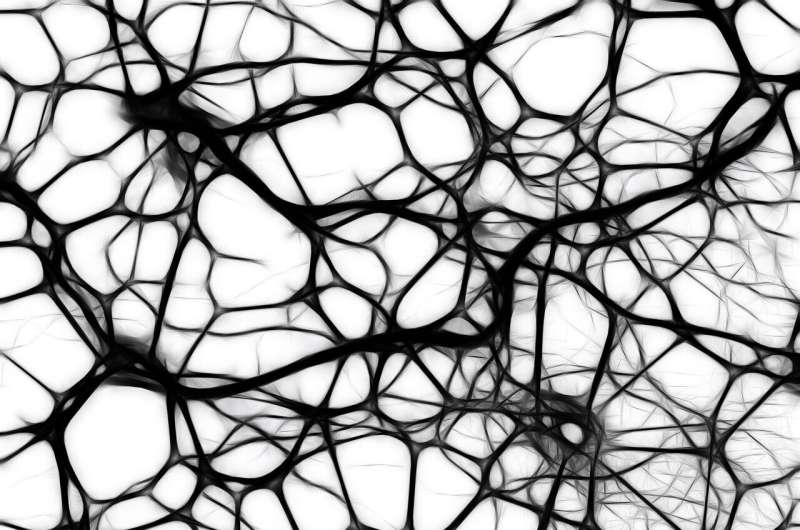Hidden network of enzymes accounts for loss of brain synapses in Alzheimer's

A new study on Alzheimer's disease by Scripps Research scientists has revealed a previously unknown biochemical cascade in the brain that leads to the destruction of synapses, the connections between nerve cells that are responsible for memory and cognition.
The findings present a fresh angle for discovering drugs that treat Alzheimer's disease, which affects roughly 50 million people worldwide. The study, led by Scripps Research Professor and Step Family Foundation Endowed Chair Stuart Lipton, MD, Ph.D., appears in the journal Science.
This newly-discovered series of abnormal chemical events, termed "protein transnitrosylation reactions," contribute to synapse loss, the main driver of memory loss and cognitive decline in Alzheimer's.
Lipton, who is also a clinical neurologist, explains that most recent attempts to develop Alzheimer's treatments have targeted the sticky protein known as beta amyloid that accumulates in the brain of patients, disrupting cell communication and causing inflammation. However, for a variety of reasons, these attempts have failed in clinical trials.
"This work gives us new hope for better therapeutic targets, as the reactions we discovered are downstream of amyloid action," Lipton says. "We've opened up a whole new avenue for drug development."
Lipton is no stranger to drug development for Alzheimer's and Parkinson's diseases. Drugs developed in and patented by his laboratory have led to four FDA-approved medicines for these diseases, including the widely prescribed drug, memantine (Namenda). "Much better drugs are needed, however," Lipton says.
A chemistry success story
In the new study, Lipton and his team used physical chemistry techniques to quantify how electrons participate in chemical reactions, as they suspected unknown processes may be taking place in the brain. Through this, they uncovered the entirely new series of biochemical events in nerve cells affected by Alzheimer's.
They found that small clumps of beta amyloid protein trigger excessive neuron activity and inflammation, leading to the destructive series of transnitrosylation reactions.
The process begins with excessive levels of nitrogen (N) and oxygen (O) atoms joining together as an "NO group," which is then transferred to a protein building block called cysteine to regulate the activity of the protein. A series of these aberrant protein reactions cuts off energy to the brain's nerve cells by disrupting their mitochondria—organelles that generate power for the cell's biochemical reactions. This eventually leads to loss of synapses connecting the nerve cells.
"We were able to show that these reactions occur in brains of Alzheimer's patients, and when we prevented these reactions in the brains of animal models of the disease, we protected the synapses," Lipton says. "Our findings suggest that it may be possible to intercede to reverse synapse damage in spite of plaques and tangles," he added, referring to "plaques" of beta amyloid and "tangles" of misfolded tau protein, both of which are characteristic of Alzheimer's disease.
He notes that while normal levels of NO foster memory and learning, excessive levels can build up as we age and become harmful to synapses.
"With this new knowledge, we may be able to restore synaptic connections in Alzheimer's patients after extensive plaques and tangles have formed in their brains," adds Tomohiro Nakamura, Ph.D., senior staff scientist in the Lipton laboratory group and first author of the study.
Revealing secret connections
Lipton says that one of the team's most incredible findings was that the three enzymes discovered to pass NO to each other along a concerted chain of events, resulting in energy failure, were previously not thought to be even remotely related to one another. Each of the enzymes is important in its own right in a completely disparate normal biochemical pathway, and yet they interact under disease conditions in a novel manner to trigger intense neuronal stress and synapse damage.
"This type of hidden or 'ghost' pathway may only become evident under disease conditions and may represent an important fundamental tenet of why we did not understand the disease process previously," Lipton says. "If we do not know about a pathway, scientists cannot study its contribution to disease or develop drugs to treat it."
While many molecular biochemical pathways have been discovered, an over-reliance on this existing body of evidence can actually impede discovery of disease processes, he adds.
"Hence, the most important aspect of the work is that we have to be on our guard to look for new pathways and new relationships of existing enzymes in order to understand and treat neurodegenerative disorders such as Alzheimer's," Lipton says.
More information: Tomohiro Nakamura et al. Noncanonical transnitrosylation network contributes to synapse loss in Alzheimer's disease, Science (2020). DOI: 10.1126/science.aaw0843


















